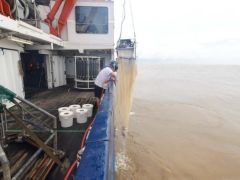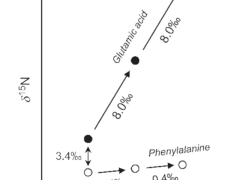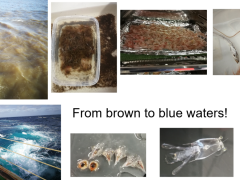
Ocean interfaces under global changes –
Exploring the fate of the Amazon River plume
19.05.2021 – Tracking zooplankton
Nutrients distribution foster different production regimes in the inner shelf, frontal, outer plume, and oceanic zones along the Amazon plume. These production regimes are linked to different phytoplankton communities, as we learned in the previous entry, but not only. Changes at the base of the food web inevitably trigger modifications at higher trophic levels, leading to different mesozooplankton food web structures and nitrogen transfer efficiencies along the plume.
Studying structures of planktonic food web requires big tools like the Multinet (Picture 1), and is challenging because the same phototrophic phytoplankton species can become mixo- or heterotrophic. Similarly, herbivorous zooplankton species can become omnivorous, detritivorous, or carnivorous depending on the quality of the incorporated food. Using biochemical measurements (δ15N-Amino Acids) of different plankton size fractions, it is now possible to study these food web structures.
A simple comparison between the δ15N values of phenylalanine (Phe) and glutamic acid (Glu) from a single organism provides insight into its trophic level or trophic position (TP, Picture. 2). The δ15N of Phe remains nearly unchanged with each trophic transfer, reflecting the isotopic composition of the primary producers and its nitrogen source (N-source proxy). However, Glu is enriched in δ15N by ~8.0 ‰ every time it get transferred to a higher position in the food web. Comparing these two amino acids isotopic composition therefore eliminates potential sources of error associated with temporal and physiological changes in a consumer’s diet. It allows us to define its step less TP in the food web with a TP of 1.0 defining autotrophs, a TP of 2.0 defining herbivores, a TP of 3.0 defining carnivores, and a TP in-between, e.g. of 2.5 or 2.6, defining omnivores, or in case it is between 1.0 and 2.0 (e.g. TP of 1.5) it defines so called mixotrophs.
However, the strength of amino acids as a tool for studying food webs does not limit only to this relation. They can provide, for instance, information about the quality of the organic matter. But, for all the analysis we make, it is necessary to take large volumes of water, and pass them through filters for collecting as many particles suspended in the water as possible. The values of δ15N of Phe itself can tell us about the source of the nitrogen supporting the food web. For instance, negative values indicate that nitrogen fixers are supplying N2 to the surface layer, while δ15NPhe values around or above 4.5‰ will point towards a larger use of nitrate by the so-called primary producers. The concentrations of all the amino acids that we find in our samples in relation to the total amount of nitrogen can be used for calculating a Degradation Index that simply points towards freshly-produced or extremely recycled organic matter according to its value.
Combining all these different approaches, we hope to define different nutrient sources in the contrasting habitats of the Amazon River Plume, the degree of recycling that microbes reach in them, and the structure of the planktonic food web, which is essential for the transfer of energy from primary producer to apex consumers like fishes.
The mesozooplankton catches via our Multinet already showed that we have largely different communities in the light limited, detritus-dominated brown waters of the Amazon estuary (Picture. 3, upper row) compared to the green and blue waters further down the Amazon river plume (Picture. 3, lower row). Our hypothesis is that the stability of the habitat together with the food quality may trigger changes in the food web structure and in the transfer efficiency of mass and energy between trophic levels in these different waters. Let’s wait for the EA-IRMS and GC-C-IRMS results to put the food web puzzle back together and to resolve this hypothesis!
Text: Fernandez-Carrera A., Loick-Wilde N., Choisnard N., Voss M. (all IOW) | click pictures to enlarge
| Expedition: | M174 |
| Mission: | MeNARP |
| Start: | 12.04.2021 - Las Palmas |
| Destination: | 31.05.2021 - Emden |


